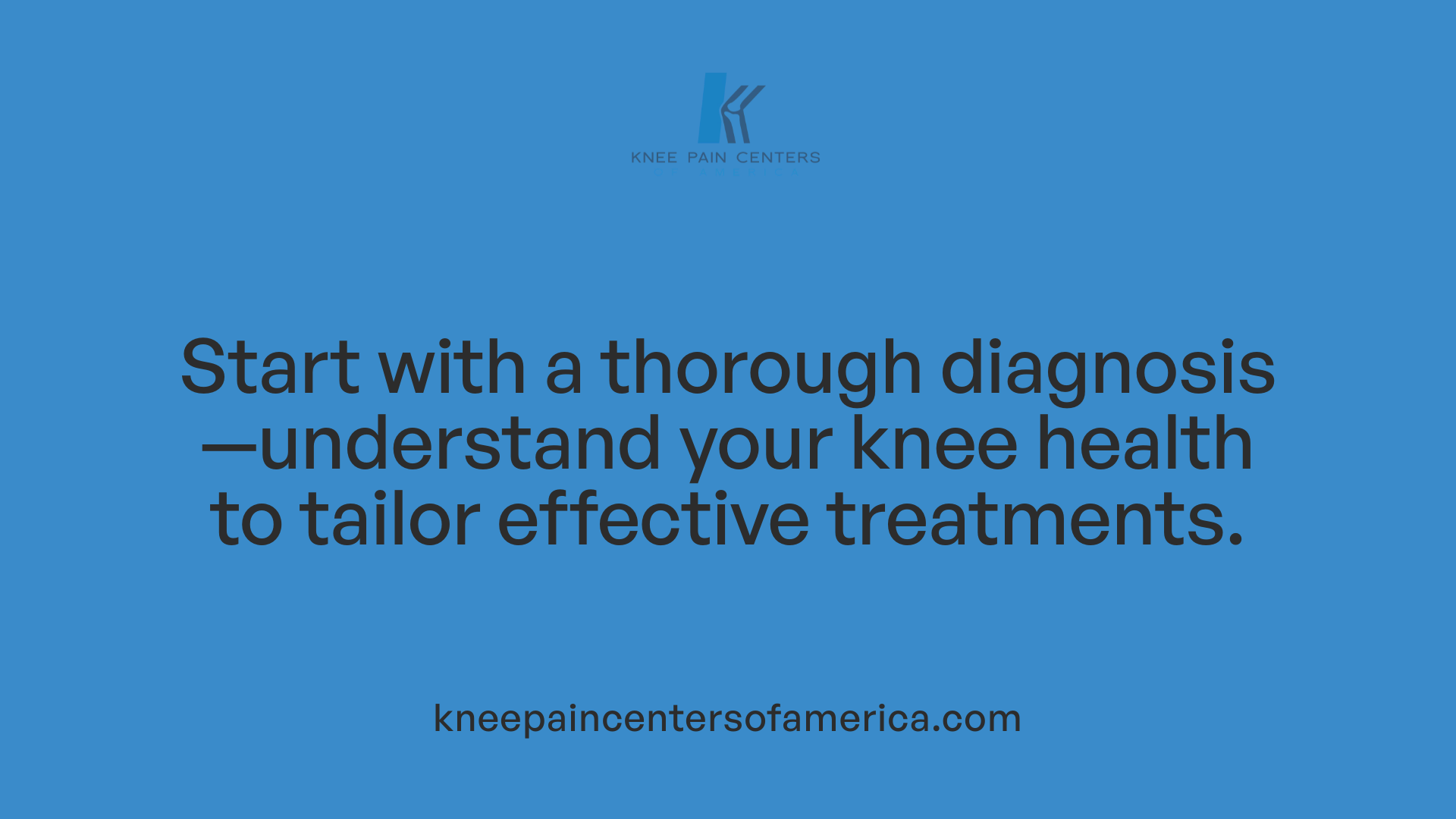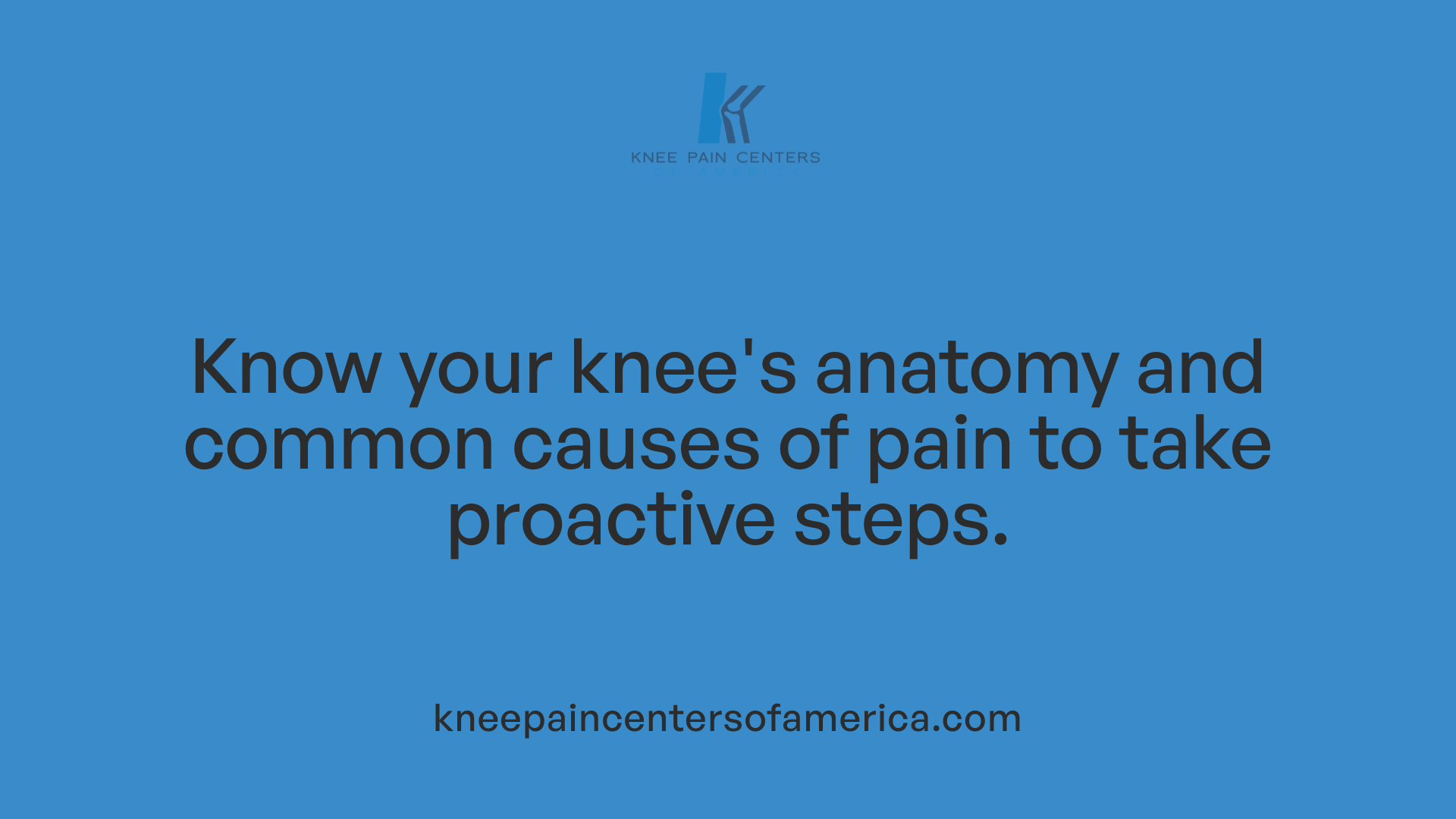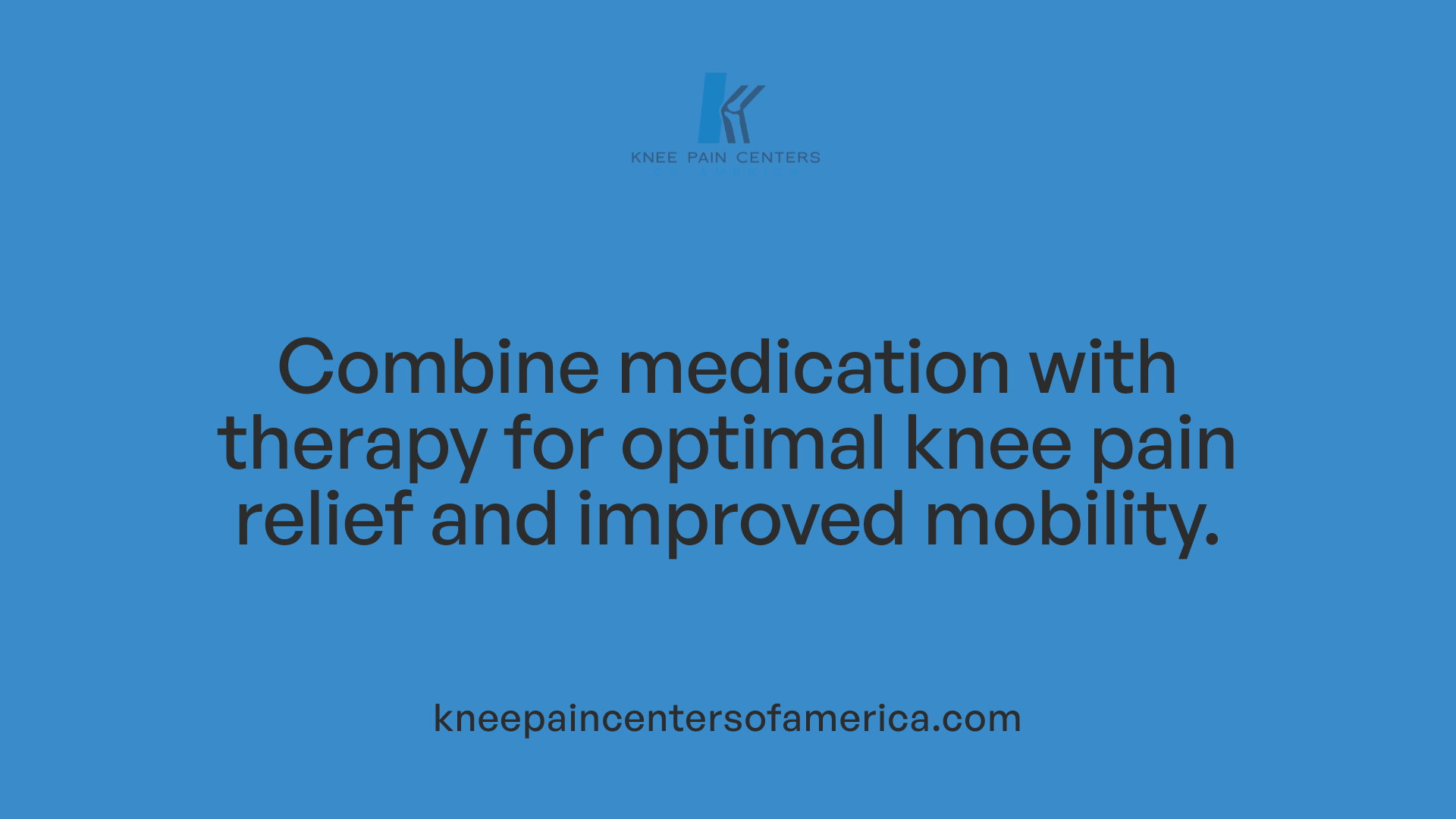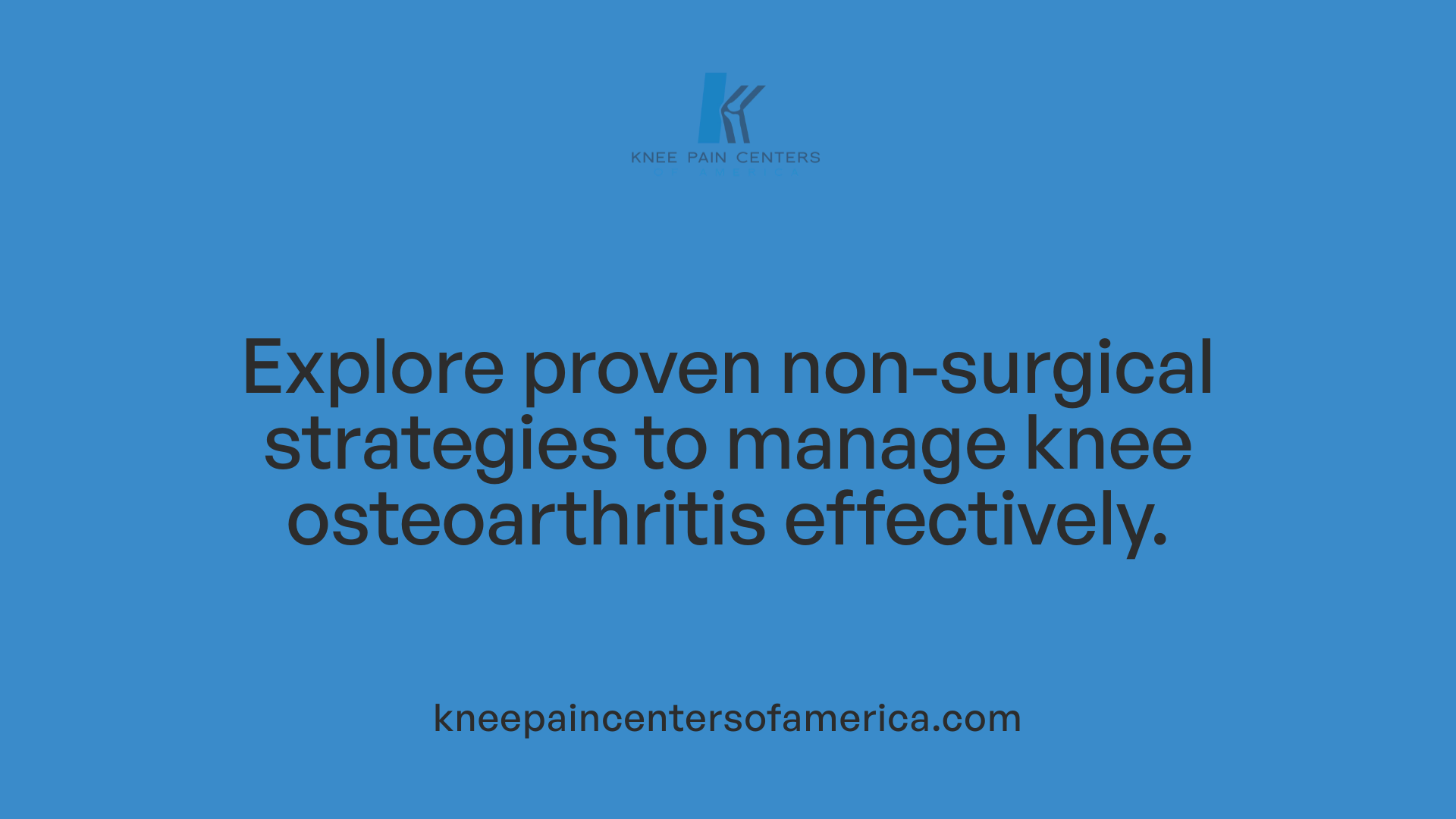Understanding Knee Conditions and the Importance of Personalized Treatment
Knee pain and osteoarthritis are prevalent conditions that affect millions worldwide, impacting mobility and quality of life. Identifying the best treatment plan requires a comprehensive understanding of your specific knee condition, informed diagnosis, and individualized care strategies. This article explores how patients and healthcare providers can collaborate to choose effective interventions — from conservative therapies to advanced surgical options — tailored to each person’s needs and lifestyle.
Comprehensive Diagnosis: The First Step to Effective Knee Treatment

How is osteoarthritis in the knee diagnosed?
Diagnosing knee osteoarthritis begins with a thorough physical examination. Healthcare providers check for tenderness, swelling, decreased range of motion, and joint stiffness. Muscle strength and gait are also assessed to understand the impact on mobility. This examination helps identify pain patterns and functional limitations.
What imaging tests are used and what do they show?
Imaging plays a crucial role in confirming osteoarthritis. X-rays are the most common and effective diagnostic tool for detecting joint space narrowing, which indicates cartilage loss. X-rays also reveal bone changes such as osteophytes (bone spurs) and subchondral sclerosis (increased bone density beneath the cartilage).
MRI scans provide detailed images of bone and soft tissues including cartilage, ligaments, and tendons. Although MRI is not routinely necessary for diagnosis, it may be used to evaluate unusual or complex cases.
How do lab tests contribute to the diagnosis?
Laboratory tests, including blood tests and joint fluid analysis, are important to rule out other causes of knee pain. These tests help differentiate osteoarthritis from inflammatory arthritides like rheumatoid arthritis or infections. Typically, blood tests are normal in osteoarthritis, supporting its degenerative rather than autoimmune nature.
How to distinguish osteoarthritis from other knee conditions?
Knee osteoarthritis usually presents with symptoms like aching pain that worsens with activity, stiffness, and sometimes swelling. Contrastingly, inflammatory arthritis often involves morning stiffness lasting longer, redness, and warmth around the joint. Imaging and lab results further aid differentiation. For example, joint space narrowing with osteophytes favors osteoarthritis, while blood markers of inflammation suggest rheumatoid arthritis or other systemic diseases.
By combining clinical evaluation, imaging, and laboratory tests, clinicians can accurately diagnose osteoarthritis and differentiate it from other knee pathologies. This comprehensive approach ensures tailored treatment plans to relieve symptoms and improve joint function.
The Anatomy and Common Causes of Knee Pain: What You Need to Know

What is the anatomy of the knee?
The knee is a complex joint consisting primarily of three bones: the femur (thigh bone), tibia (shin bone), and patella (kneecap). These bones are cushioned and protected by articular cartilage, which allows smooth movement. Ligaments and tendons provide stability and connect muscles that facilitate knee motion. Muscles around the knee support its strength and flexibility.
What types of arthritis affect the knee?
Arthritis in the knee can be broadly divided into degenerative and inflammatory types:
- Osteoarthritis (OA): The most common form, caused by wear-and-tear and progressive cartilage deterioration.
- Rheumatoid arthritis (RA): An autoimmune inflammatory arthritis with symptoms like morning stiffness, redness, and swelling.
- Other forms: Include juvenile idiopathic arthritis, spondyloarthritis, gout, post-traumatic arthritis, infectious arthritis, and reactive arthritis.
What risk factors contribute to knee osteoarthritis?
Several factors increase the likelihood of developing knee OA, including:
- Age over 50 years
- Excess body weight, which increases knee load
- Previous knee injuries or surgeries
- Anatomical abnormalities such as poor joint alignment
- Jobs or activities that place repeated stress on the knees
- Genetic predisposition and family history of autoimmune diseases
What symptoms indicate different knee conditions?
Knee pain symptoms vary depending on the underlying condition:
- Osteoarthritis: Aching, stiffness, swelling, pain worsening with activity, crepitus (cracking sounds), and sometimes catching or locking.
- Rheumatoid arthritis: Joint pain with morning stiffness, swelling, redness, and systemic symptoms.
- Other causes: Overuse syndromes like runner's knee cause localized pain without arthritis features.
Understanding the knee's anatomy and the types and causes of arthritis aids in recognizing symptoms early and pursuing appropriate diagnosis and treatment.
Effective Medical Treatments for Knee Pain: Balancing Medications and Therapy

What are the most effective medical treatments for knee pain?
For knee pain, especially related to osteoarthritis and other common causes, effective treatment typically combines conservative methods, medications, and physical therapy.
Conservative Treatment Approaches
Managing knee pain starts with non-pharmacologic measures including lifestyle adjustments such as weight loss to reduce joint stress and activity modification. Use of supportive devices like knee braces or canes can also help alleviate pain and improve function. Self-care strategies including heat and cold therapy, as well as movement therapies like yoga and tai chi, promote flexibility and reduce stiffness.
Pharmacological Options Including Analgesics and NSAIDs
Medications are often used to relieve pain and inflammation. Acetaminophen (Tylenol) works for mild to moderate pain, while nonsteroidal anti-inflammatory drugs (NSAIDs) such as ibuprofen and naproxen address pain by reducing inflammation. Topical NSAID gels and capsaicin creams provide targeted relief with fewer systemic effects.
Role of Corticosteroid Injections
For more persistent or severe symptoms, intra-articular corticosteroid injections offer short-term pain relief by reducing joint inflammation. These injections are helpful during flare-ups but are not recommended for frequent use due to potential cartilage damage.
Physical Therapy and Exercise Benefits
Supervised physical therapy programs strongly improve knee function and reduce pain. Exercises focus on strengthening muscles around the knee, increasing joint stability, and enhancing flexibility. Low-impact aerobic activities such as walking, swimming, and cycling are beneficial. Exercise also supports weight management, further reducing pressure on knee joints.
Combining these treatments under an interprofessional care approach optimizes outcomes by addressing pain relief, mobility, and quality of life for individuals experiencing knee pain.
Non-Surgical Management of Knee Osteoarthritis: Strategies That Work

What non-surgical options are available for managing knee osteoarthritis?
Non-surgical management of knee osteoarthritis (OA) involves a multifaceted approach tailored to relieve pain, improve function, and slow disease progression.
Physical Therapy and Supervised Exercise
Supervised exercise programs play a crucial role and are strongly recommended for knee OA patients. Activities such as walking, cycling, swimming, yoga, and tai chi not only improve muscle strength but also enhance joint flexibility and overall mobility. Physical therapists design individualized regimens that focus on low-impact aerobic exercises and muscle strengthening around the knee, which can significantly reduce pain and improve quality of life.
Weight Loss and Its Impact
Weight management is another important strategy. Since each pound lost can reduce the load on the knee joint by approximately four pounds, weight loss substantially decreases mechanical stress on the joints. This can reduce pain severity and potentially slow cartilage deterioration, especially in overweight or obese individuals.
Use of Braces and Assistive Devices
Biomechanical aids such as knee braces and assistive devices (walking canes) can offer symptomatic relief. Braces, particularly for those with varus alignment, have moderate evidence supporting their ability to improve pain and function. Canes are moderately recommended to reduce pain and enhance walking ability. However, lateral wedge insoles are generally discouraged due to lack of proven efficacy.
Topical NSAIDs and Analgesics
Topical nonsteroidal anti-inflammatory drugs (NSAIDs) are strongly recommended for managing pain and improving function, providing effective local treatment with fewer systemic side effects. Topical analgesics like capsaicin creams and NSAID gels complement oral medications for mild to moderate pain relief.
Alternative Therapies and Their Evidence Base
Alternative treatments such as acupuncture, glucosamine, chondroitin, and omega-3 supplements are used by some patients. While acupuncture shows some promise, evidence for glucosamine and chondroitin remains inconsistent, leading to cautious recommendations. These therapies may be considered adjuncts but should not replace conventional management.
Through a combination of these non-surgical options—exercise, weight management, assistive devices, topical treatments, and selective alternative therapies—patients can achieve substantial improvements without immediate recourse to surgery.
When Surgery Becomes Necessary: Indications and Options for Knee Osteoarthritis

When should a patient consider surgery for knee osteoarthritis?
Surgery is typically considered for knee osteoarthritis when a patient experiences persistent, severe pain and significant functional limitations that do not improve despite at least six months of conservative management. This includes ineffective relief from treatments such as NSAIDs, physical therapy, weight loss, and activity modifications. Surgery aims to improve pain, restore function, and enhance quality of life when other options have failed.
Criteria for surgical intervention
- Failure of nonsurgical treatments to control symptoms
- Persistent pain at rest or with activity
- Radiographic evidence of advanced osteoarthritis (e.g., Kellgren & Lawrence grade 3 or 4)
- Mechanical symptoms such as catching or locking due to loose bodies
- Significant disability impacting daily living
Types of knee surgeries available
| Surgical Procedure |
Description |
Appropriate Candidates |
| Total Knee Arthroplasty (TKA) |
Replacement of the entire knee joint with prosthetic components |
Patients with severe, tricompartmental OA |
| Partial Knee Arthroplasty |
Replacement of only the damaged compartment of the knee |
Those with localized OA in a single knee compartment |
| High Tibial Osteotomy (HTO) |
Realignment surgery to shift load away from the damaged area |
Younger, active patients with medial compartment OA |
| Arthroscopic Procedures |
Debridement or removal of loose bodies causing mechanical symptoms |
Select patients with mechanical issues, not routine for OA |
Importance of timing and patient evaluation
Appropriate timing of surgery is crucial. Performing surgery too early may expose patients to unnecessary risks, while delaying may lead to worsened joint damage and muscle weakness. Preoperative evaluation includes assessing pain severity, radiographic changes, comorbidities, and patient expectations to optimize outcomes.
Postoperative care and rehabilitation
Successful results rely heavily on structured postoperative rehabilitation involving physical therapy to restore range of motion, muscle strength, and function. Patient education about activity modifications and adherence to rehabilitation protocols facilitates recovery and prolongs implant longevity.
An interprofessional team involving surgeons, physiotherapists, rheumatologists, and nursing staff is recommended to provide comprehensive care before and after surgery.
Lifestyle Modifications: The Cornerstone of Long-Term Knee Health
What role do lifestyle changes play in managing knee pain and osteoarthritis?
Lifestyle changes play a vital role in managing knee pain and osteoarthritis by reducing stress on the joints and improving overall joint health. Key strategies can help maintain mobility, reduce symptoms, and slow disease progression.
Importance of Low-Impact Exercise
Engaging in regular low-impact exercises such as walking, cycling, swimming, yoga, and tai chi is strongly recommended for people with knee osteoarthritis. These activities strengthen muscles around the knee, improve joint flexibility, and minimize stiffness and pain without imposing excessive strain. Physical therapy can support tailored exercise programs to maximize benefit.
Weight Management Benefits
Maintaining a healthy weight is crucial since excess body weight places additional mechanical stress on weight-bearing joints like the knees. For every pound of weight lost, an estimated four pounds of pressure is relieved on the knees. Weight loss can lead to diminished pain, enhanced function, and decreased disease progression.
Dietary and Anti-Inflammatory Strategies
Adopting an anti-inflammatory diet—rich in fruits, vegetables, omega-3 fatty acids, and whole grains—can provide supportive benefits when managing osteoarthritis symptoms. While supplements like glucosamine and chondroitin have limited evidence, omega-3 fatty acids show some promise in reducing inflammation.
Joint Protection and Injury Prevention
Lifestyle modifications also include protecting joints from injury by avoiding high-impact activities that can exacerbate cartilage wear. Using supportive devices such as braces or walking aids, practicing proper body mechanics during movement, and ensuring safe environments help prevent joint damage and maintain knee health.
Together, these lifestyle approaches form the cornerstone of effective long-term management of knee osteoarthritis, improving quality of life and mobility while reducing reliance on medications or surgery.
Emerging Therapies and Medical Advances in Knee Osteoarthritis Treatment
Are there any new medical advances in the treatment of knee osteoarthritis?
Recent advances in knee osteoarthritis (OA) include minimally invasive procedures and regenerative medicine that address pain and joint deterioration with the goal of improving patient outcomes.
Minimally Invasive Procedures
Genicular artery embolization (GAE) is an innovative, image-guided minimally invasive technique that reduces blood flow to areas of inflammation within the knee. This procedure has demonstrated promising results in alleviating pain and potentially slowing OA progression by targeting inflammatory signals. Radiofrequency ablation (RFA) is another minimally invasive option that applies thermal energy to interrupt nerve signals transmitting pain from the knee joint. RFA provides temporary pain relief and improves quality of life for patients with knee OA.
Regenerative Medicine
Regenerative approaches like platelet-rich plasma (PRP) injections aim to harness the body's healing mechanisms to repair damaged cartilage and improve joint function. PRP involves concentrating platelets from the patient's blood and injecting them into the knee to stimulate tissue regeneration. Stem cell therapies, including mesenchymal stem cells derived from bone marrow or adipose tissue, are being studied for their potential to regenerate cartilage and reduce inflammation in osteoarthritic joints. Though still experimental, these therapies offer hope for disease-modifying treatments in the future.
Evaluation of Evidence and Ongoing Research
While these emerging therapies show potential, current evidence is mixed and often limited by small study sizes or lack of long-term data. PRP and stem cell therapies are not yet widely recommended due to insufficient high-quality evidence, and hyaluronic acid injections, previously popular, are now generally discouraged because of limited clinical benefit and cost-effectiveness. Research efforts continue to evaluate optimal protocols, patient selection, and long-term effectiveness to better define their role. Multidisciplinary approaches and personalized treatment plans are emphasized to integrate new advances safely and effectively.
These medical advances complement conventional treatments and represent an evolving landscape focused on improving pain management and joint preservation for patients with knee osteoarthritis.
Integrating Patient Education and Self-Management for Optimal Outcomes
Why Are Patient Education Programs Strongly Recommended?
Patient education programs are crucial in managing knee osteoarthritis as they improve pain and enhance patients' understanding of their condition. Through education, patients learn about disease progression, treatment options, and strategies to maintain joint function.
What Self-Management Strategies Help Patients With Knee Osteoarthritis?
Self-management programs empower patients to take an active role in their care. These include regular low-impact exercise like walking, cycling, yoga, and tai chi to reduce pain and improve mobility. Weight management is also important since losing even a small amount of weight significantly reduces pressure on the knees.
Additionally, heat and cold therapies, topical NSAIDs, and assistive devices such as braces or canes can be incorporated. Patients are encouraged to modify activities to protect their joints and maintain function.
How Can Patients Cope With Chronic Knee Pain?
Coping mechanisms for chronic pain emphasize patience and adaptations to daily life. Techniques include relaxation, mindfulness, and the use of alternative therapies like acupuncture or supplements, although evidence varies. Emotional support and counseling may also benefit mental well-being and improve pain perception.
Why Is an Interdisciplinary Care Team Important?
Managing knee osteoarthritis effectively requires a team approach involving surgeons, rheumatologists, physiotherapists, dietitians, pharmacists, and nursing staff. This team collaborates to provide tailored treatments, rehabilitation, patient education, and psychological support. Such coordinated care improves outcomes and quality of life for patients.
Supporting patients with comprehensive education and self-management helps delay disease progression, relieve symptoms, and maintain independence in daily activities.
Tailoring Treatment Plans: Factors to Consider for the Best Outcomes
Individual Risk Factors and Comorbidities
When creating a treatment plan for knee osteoarthritis or other types of knee arthritis, it is crucial to consider individual risk factors. These include age, obesity, previous injuries, anatomical differences, and the presence of autoimmune or metabolic conditions such as rheumatoid arthritis or diabetes. Comorbidities may affect both treatment options and prognosis; for example, obesity increases joint load and may necessitate prioritizing weight loss strategies.
Severity and Stage of Knee Condition
Treatment approaches are strongly influenced by the severity and stage of knee disease. Early-stage osteoarthritis usually responds well to conservative therapies like physical physical therapy, supervised low-impact exercises (e.g., cycling, walking, yoga), and NSAIDs for pain management. Advanced stages characterized by significant cartilage loss, joint space narrowing, and severe pain may require surgical intervention such as osteotomy or total knee replacement (TKA).
Patient Lifestyle and Preferences
Patient lifestyle and preferences are fundamental in guiding treatment decisions. Many patients benefit from activity modifications that allow continued mobility with minimal pain, incorporating exercise therapies like tai chi and aquatic aerobics. Preferences regarding medications, willingness for injections or surgery, and openness to alternative therapies such as acupuncture or supplements should also be assessed to create a patient-centered plan.
Balancing Benefits and Risks of Treatments
A balanced approach acknowledges the benefits and potential risks associated with treatments. NSAIDs and acetaminophen are commonly used, but risks like gastrointestinal side effects or cardiovascular concerns must be managed. Corticosteroid injections offer rapid relief but should be limited due to potential cartilage damage with repeated use. Surgical options typically improve function and reduce pain but require careful patient selection and postoperative rehabilitation. Some therapies, like hyaluronic acid injections or platelet-rich plasma, lack sufficient evidence for routine use.
In summary, the best outcomes arise from individualized treatment plans that weigh personal risk factors, the stage of disease, patient preferences, and a careful assessment of treatment benefits and risks, emphasizing a compassionate, evidence-based approach.
Supporting Joint Health Beyond Treatment: Long-Term Care and Monitoring
Why Is Ongoing Monitoring Crucial for Knee Osteoarthritis?
Long-term management of knee osteoarthritis requires regular monitoring to track symptom changes and joint health. Regular check-ins with healthcare providers help identify any worsening of pain, increased stiffness, swelling, or decreased mobility. Early detection of progression enables timely adjustments to treatment approaches, potentially delaying surgical interventions.
What Activity Modifications Help Maintain Joint Health?
Patients are encouraged to engage in low-impact exercises such as walking, cycling, swimming, yoga, and tai chi. These activities strengthen muscles, improve joint flexibility, and reduce stiffness without overloading the joint.
Weight management plays an important role; losing even a small amount of weight can significantly reduce pressure on the knee joint, easing symptoms.
Avoiding high-impact activities that stress the knees, like running or jumping, helps prevent further cartilage damage.
Recognizing Signs of Symptom Progression
Progression signs include increasing pain intensity or frequency, stiffness lasting longer than usual, new swelling or warmth in the knee, or episodes of knee locking or buckling. Noticing pain at rest or during night can indicate advancing osteoarthritis.
Recurrent or worsening symptoms suggest a need for reassessment and potential escalation in treatment.
When Should Treatment Plans Be Revisited?
Patients should revisit their healthcare providers if symptoms persist despite current treatments or if new symptoms develop. Also, changes in activity levels, function, or quality of life warrant reevaluation.
Treatment reassessment may involve additional imaging or laboratory tests to reassess joint condition, and modifications like starting new medications, physical therapies, or discussing surgical options.
Maintaining communication with an interprofessional healthcare team—including physicians, physical therapists, and dietitians—helps tailor long-term care for the best outcomes. Patient education and self-management programs are vital for empowering individuals to take control of their condition and maintain joint health over time.
Identifying the Right Path for Your Knee Health
Choosing the best treatment plan for your knee condition is a personalized journey that begins with accurate diagnosis and understanding your unique situation. Through a combination of conservative management, lifestyle modification, and when necessary, surgical intervention, it is possible to effectively manage symptoms, slow disease progression, and maintain mobility. Staying informed, engaging with your healthcare team, and actively participating in self-care are critical to improving your knee health and overall quality of life.
References